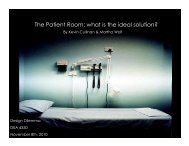The role of physical design and informal communication
The role of physical design and informal communication
The role of physical design and informal communication
Create successful ePaper yourself
Turn your PDF publications into a flip-book with our unique Google optimized e-Paper software.
there. Close to 40% <strong>of</strong> “Seeking Assistance” occurred in the corridor which coincides<br />
with observation <strong>of</strong> the GN frequently exiting the patient room <strong>and</strong> walking into the<br />
corridor to find a staff member to assist her. <strong>The</strong> corridor was also the site <strong>of</strong> 41% <strong>of</strong><br />
“Providing Advice,” also confirmed by observation <strong>of</strong> the GN answering nursing<br />
assistants’ questions outside <strong>of</strong> patient rooms.<br />
<strong>The</strong> CWM tool data, observation, <strong>and</strong> interviews revealed that the med room<br />
served as an important space for social interaction. In fact, 45% <strong>of</strong> all social<br />
interaction occurred there. <strong>The</strong> med room is a place where all RNs need to go<br />
frequently throughout their shift, so there was <strong>of</strong>ten more than one RN in the room at<br />
once. When in the med room during observation, it was common to see RNs working<br />
while socializing – that is, dispensing meds while making a joke, venting about a<br />
patient’s family member, talking about their kids, etc. <strong>The</strong>re was also a radio in the<br />
med room, <strong>and</strong> it was on about half the time, almost serving as a signal that this is an<br />
<strong>informal</strong> place where it is acceptable to discuss certain topics that wouldn’t be<br />
appropriate elsewhere on the unit. It is important to note that the med room is a space<br />
enclosed by four walls <strong>and</strong> a door, as opposed to being open to the rest <strong>of</strong> the unit.<br />
According to information obtained in focused interviews, this <strong>design</strong> is the reason that<br />
so much social interaction occurs there. As one interviewee describes it:<br />
“Everyone thinks that because the door is shut, that it’s like a little<br />
room <strong>and</strong> no one can hear you. Because it’s the four walls <strong>and</strong><br />
you’re in there.”<br />
Another interviewee provides a similar response:<br />
“That’s the only place out <strong>of</strong> earshot <strong>of</strong> patients that you can, just<br />
like, say whatever you feel like, you know, you don’t have to<br />
sensor yourself because it’s closed.”<br />
83







